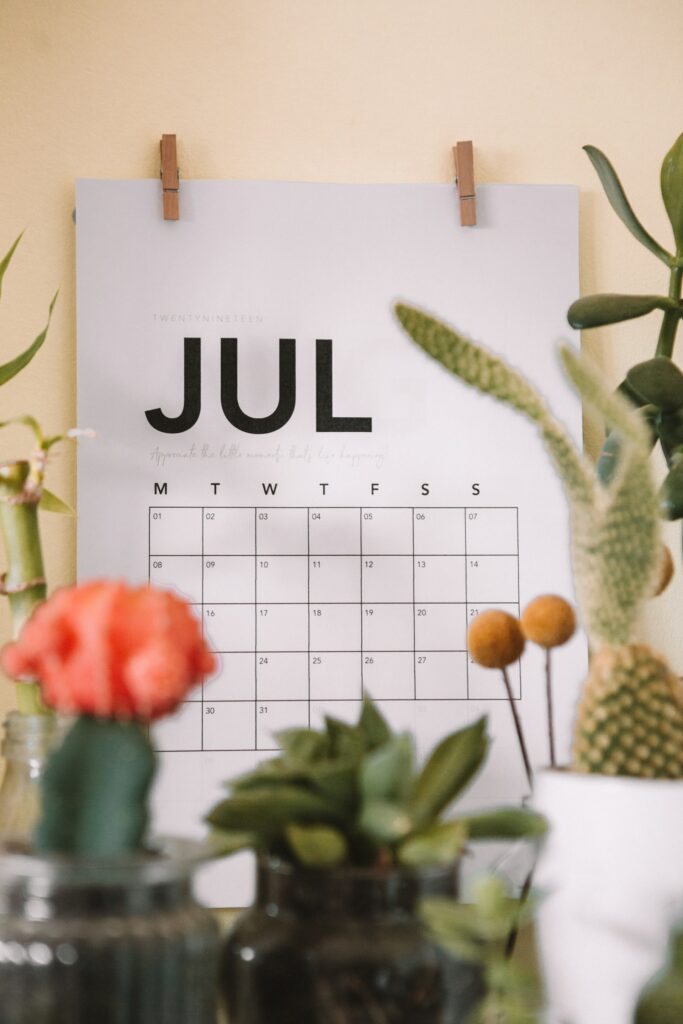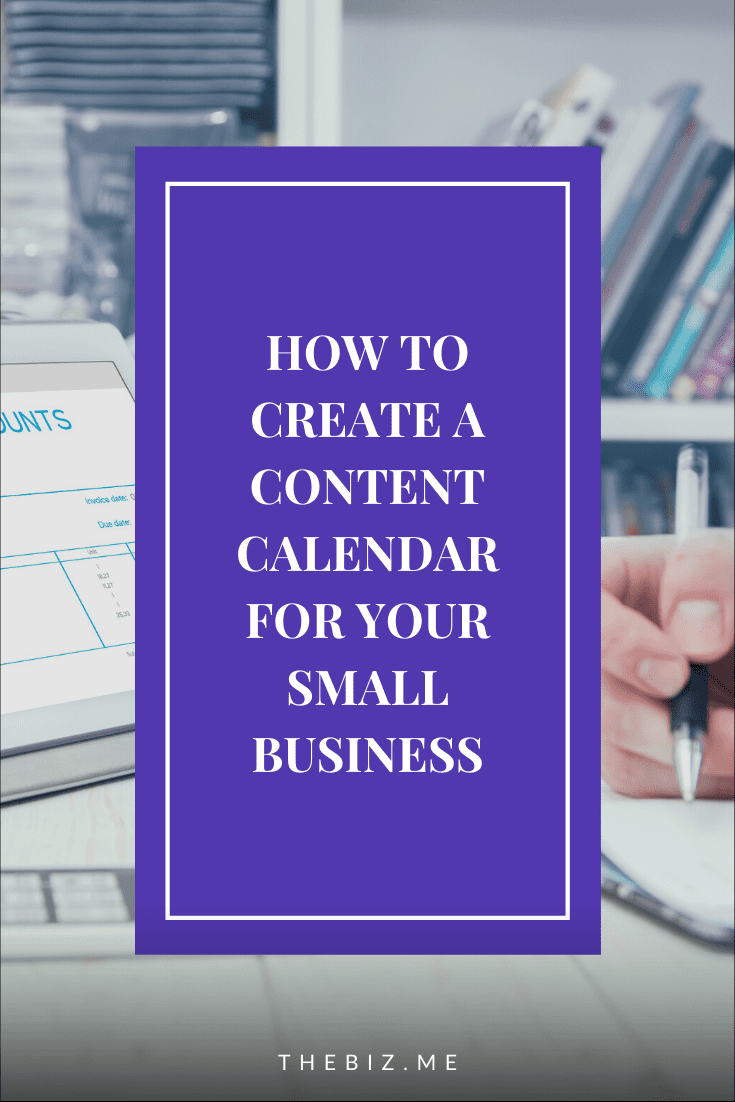
A content calendar – sometimes called an editorial calendar – is a great way to plan, organize, and schedule your marketing content for the upcoming days, weeks, or even months. Professionals and small businesses need to keep track of the marketing initiatives they are doing in order to achieve their goals. Having a content calendar is a super effective way to visualize your content as a path that leads you to your goals!
Starting a content calendar is simple. Basically, you’re creating a schedule that includes all the content you will need in order to reach your goals. This schedule might include future blog posts, social media content, video content, email campaigns, and more. While this might seem overwhelming, we urge you to trust the process. Even if spreadsheets usually send a shiver up your spine, I’ll show you how just a simple calendar template that you create in 15 minutes or less can change the way you create and plan your content.
Even if you’ve tried a calendar before and gave up on it. This article will convince you that it’s not just a good idea to have a content calendar, it can completely change the way you approach your marketing. I’ll dive in deeper and talk more about why it works how you can create a content calendar (also sometimes called an editorial calendar) of your own that will actually work for you!
Ready to start? Let’s go!
Keep reading to find out:
What Is a Content Calendar?

First things first, before we start planning anything we need to go over the basic stuff. A lot of people who have a blog or regularly post social media content for a small business have heard the term “content calendar” before but they might not have a clear idea of what it means.
A content calendar is a tool – we usually use a spreadsheet, but it can be anything – that you can use as a schedule for your future content and marketing campaigns. This calendar is where you will go to plan out all of the content you want to create over the next year, ideally.
Why Is Content Calendar Important?
Even if you understand what a content calendar is, you might not understand why having one is so important. Of course, big organizations need to have a plan because they’re spending lots of money on teams and advertising, but does it really matter if you’re a entrepreneur or small business owner?
You bet it does! Even if you’re just using your calendar to plan out the one piece of social media content per day, it can help you keep your messaging cohesive and streamline your efforts. Don’t worry, though. You aren’t tied to this plan. You can always test, adjust, and pivot if you notice something isn’t working or want to try something new.
Having a calendar to plan out your content can help you to:
1. Stop Neglecting Your Content
One of the biggest benefits is that you can finally stop neglecting your content. Let’s face it, when we’re busy, the regular, everyday social media content we post is usually the first thing to get pushed aside. For instance, if you’re a designer whose main focus is to come up with a design for your new line of t-shirts and you’re in a time crunch, you’re probably going to stop posting on social media, neglect that latest blog post and forget to send your monthly email newsletter.
But, if you have everything planned out in an editorial calendar, you’ll have the structure you need to just upload your content and hit “post” or “send.” You won’t forget to publish on your social media or stream those new blog posts. You can keep track of your content marketing strategy so you have people who are eager to buy that item you’re working so hard on.
2. Save Time
Those of you who are already creating content for social media know that it takes much more time than we think it will. It’s not just about posting it; it is about coming up with the ideas, writing and designing the post itself (and coming up with good hashtags) and responding to comments that come in. It all takes so much time!
Not to mention, there are days when we can’t come up with good content ideas, no matter how hard we try. We scroll through our photos… nothing. Surf other people’s feeds… nothing. Dive into Goodreads to find some inspiring quote to share… still nothing. You start to think, “Gosh! Maybe I’ll just post an emoji and be done with it!” (please don’t do that)
Having a calendar where you plan your content across the various social media channels will help you immensely during these times of content crisis, because you’ll already have everything all ready to post. Plus, when you batch your content ahead of time, you can be much more productive (more on that later on in this post).
3. Have More Clarity On Your Strategy
Keeping a calendar to keep track of your content forces you to look at the bigger picture and develop a strategy. When you don’t have a calendar, it can seem like everything is all over the place. You don’t have clarity on what you’re going to post or why you’re doing it.
With a calendar, it’s much easier to publish meaningful content and it’s also easier to plan your content around important dates like Mother’s Day, Valentine’s Day, Christmas, and so on.
4. Create Better Content

Let’s say you work in a restaurant. You need photos of your dishes to post on social media and in some upcoming blog posts. Well, that involves a little planning; you might need a photographer, some props, and of course, the food. Even if you’re going to do it all yourself, you still need the right lighting, location, and time in your schedule to do it.
Organizing all the moving parts requires planning. If you don’t plan and you simply snap a quick photo of one of your dishes, it’s probably not going to be your best content. When we do things last minute, they’re often not quite at the level you want them to be. So, planning in advance with a calendar is the best way to create well thought-out and amazing content and posts for your business.
5. Get Better Results
Another benefit that comes with planning your content is it helps you to be more aware of your content and how it performs.
Social media is the best way to run some tests with the type of content you post, the format, the frequency, and even the best time of the day. On your calendar, you can keep track of everything you’ve tried, and then, after you look at how it performs (using analytics) you can make adjustments as needed!
Before You Create Your Content Calendar
Curious how to set up a content calendar template for your business? We’ll get to that soon, but first, we want to talk about what you need to do before you build out your calendar. First, you need to define and write down your goals for your content. It might look something like, “increase sales of screen-printed t-shirts,” or “grow my email list by 1,000 subscribers,” or “earn enough this quarter to invest in a virtual assistant,” or even “get my content republished by a major publication.”
When you have clear goals, it’s easier to understand what kind of content you should publish. Without goals, I promise you will be posting content that doesn’t help you grow. People fall into the trap of posting just to post, and while the content might be interesting or cute, it doesn’t move the needle. It doesn’t take your audience on a journey or tie into anything bigger that you want to offer.
Once you’ve written down some clear content goals, you should create objectives that will serve as metrics for those goals. They will give you tangible evidence of what you want to achieve. Don’t be too vague, though. For example, “increasing sales” or “become an authority” are well-intentioned, but way too broad. It’s not possible to measure these objectives to know whether you’ve achieved them and because they’re so vast, it’s easy to feel paralyzed and not know where to start.
Instead, come up with some actual numbers that will help you measure your success. I promise, you’ll be more motivated to achieve them when you can see how close you’re coming to achieving your objectives. Give them a number and a time frame. It doesn’t need to be a huge number. Start small. These things take time, and you can keep adjusting your metrics as you accomplish them.
When you know your goals and objectives, you can see what kind of content will likely lead you to those results. Seems pretty straightforward, doesn’t it? That’s because it is!
A Practical Example
Goal
To become an authority on how to cook healthy vegan food.
Objectives
- Get to 500 followers on Instagram in 4 months;
- Receive 300 visits/month on my blog in 4 months;
- Get 200 subscribers on my email list in 4 months.
Actions
Once you have goals and objectives, it’s time to think of how you can start to plan your content. Plan your content as if it were the path that leads you to your objectives.
Objective #1
Get to 500 followers on Instagram in 4 months
Objective #1 Actions
- Share 1 post/week on my personal Facebook account that promotes my Instagram page;
- Post 12 in feed posts per month on Instagram;
- Post to stories 5 times/week;
- Interact with vegan influencers;
- Create a cooking challenge;
- Start my weekly IGTV series called “4 easy vegan breakfast ideas”
- Share my Instagram posts on Twitter;
- Share my Instagram posts on Pinterest;
- Insert a link on my blog posts with a call to action to my Instagram.
So here are a few examples of actions for objective #1. We have narrowed everything down to these small actions, but these can still can be broken down a little bit more. In addition to just defining the content of your posts, you can also define the themes of your posts and the desired outcome.
If all these steps seem like too much, keep in mind that you can do as much or as little as you want. You don’t need to have multiple many goals and objectives. In fact, you can define one goal at a time and then add more later. The focus here should be on the quality above all else.
No matter how much you decide to do, once you have mapped out your goals, objectives, and actions, it’s time to plan your content. Looking at the example above, we know we’re going to need 12 in feed posts for Instagram. We’ll use the calendar to outline what these posts are going to be about.
How to Come Up with Post Ideas

This is, for me, the most exciting part. But, I acknowledge that it can be the most frightening part for some people. It can be overwhelming because you’re staring at a blank calendar and you’re not sure where to start or what to post.
But remember, you already have a basic outline of the actions you would like to take to achieve your goals and objectives. The topics and the types of content you will create will tie into them.
You know your audience or the kind of audience you want to attract. If you’re focusing on selling more screen-printed t-shirts, maybe you can create a campaign showing people who fit your target demographic wearing the shirts. You can also share messages on your business’ social media page that encourage people to treat themselves, express themselves, and update their closet.
If you’re feeling completely lost or need some inspiration, take a look at this post where we share 18 Social Media Posts for Small Businesses.
How to Create the Right Content for Your Audience
Knowing your audience means you need to consider their problems and difficulties so you can create content that will help address these issues. For example, if you want to sell access to your easy recipes, you need to know that your audience doesn’t have a lot of time to cook or doesn’t have the skills to do it confidently.
So when marketing your products, focus on that. Show them that they can create high-quality healthy meals. Show them that they can pull of one of those beautiful dishes from the magazines in just a few minutes.
But besides that, show them how you can improve their life. Share the list of ingredients from one of your meals and explain how each ingredient is good for their health. Do a video showing how you cook the meal. Give them tips to make the most of the meals with tips to enjoy the leftovers in a different way.
This is content marketing. And this is how you create an amazing content strategy and use social media, blog posts, and other types of content to grow your business.
So, now that you get the why, it’s time to dive into the how. Let’s take your goals and your audience into consideration and start brainstorming content ideas! It’s finally time to make a content calendar and map out the types of content you’re going to publish in the future.
How do I Make a Content Calendar?
So, the content you create needs to be deeply interconnected with your goals, objectives, and your audience. Therefore, the editorial calendar you create will be vastly different from the calendar someone else makes for their business. There is no one size fits all here!
The way you set up your content calendar will also depend a lot on the platforms you decide to include in your content marketing strategy. Most business owners have a blog, an email list, and a profile on at least one or two social media channels.
Seem too overwhelming? That’s because you don’t have a content calendar yet! So now, I will teach you, step by step, how to make a calendar that works for you. Here are the essential sections you should include in your calendar template:
1. Create One Tab for Each Month of the Year on a Spreadsheet
Create twelve tabs on a spreadsheet, each one for a month of the year. You’ll use this same file all year long and each month, you will fill out one tab with all of the content you are going to post so that everything is all in one place.
2. Doodle Your Content Calendar Structure
Doodle your content strategy on a piece of scrap paper before you start building out the calendar. This will make it easier for you to rearrange the information on your table in a more practical way. You can determine the type of content you need to fill out your calendar rather than having to add and delete a dozen rows in the process.
3. Continue Building Your Content Calendar Template

Here’s a list of steps that you can follow to continue to build out your calendar.
1. Divide your month into weeks
2. Divide your weeks into days (Sunday, Monday, Tuesday, etc.)
3. Within each day, you should include:
a) The platform where you’re going to publish a piece of content (blog, email, tweet, etc.)
b) The topic of the content (what is it about)
c) A description (it can be the caption of your post or notes on what to write)
d) The link to the image you’re going to post (if it’s a social media post)
e) The time you’re going to publish the piece of content
This is a basic way to organize your content but, of course, you can adapt this calendar template to work for you and your business. Include whatever you feel like is important and delete everything you think is not as necessary.
Bonus Tip #1: Batch Your Content Creation
The entire goal of a calendar like this is to have an organized document so you can be more streamlined and productive. Creating this calendar can also help you batch your content. What do I mean by that?
When we go to social media, we need a lot of stuff for just one post. Let’s look at a simple post on Instagram, for example. You need to:
- Take a picture
- Edit the picture
- Think about a caption
- Write the caption
- Choose the hashtags
- Post
It’s a lot of steps and it’s a lot of switching between tasks. This kind of multitasking is a crazy amount of work for our brains! Instead, you can use your content calendar to organize a whole month’s worth of posts which can help you work in batches.
Look at the kind of content you want to post for the coming month, including social media content, blog posts, email, etc. Count how many photos you will need, then set aside an hour to take all the photos, another half an hour to edit all the photos, and so on.
As you can imagine, it’s so much easier to get all of this content created when you’re working in batches like this. In just one afternoon, you can have all the content you will need for the entire month all ready to go and a plan for when and where to post it.
Bonus Tip #2: Create Two – or More – Different Content Calendars
Different platforms may need different content calendars. No, you don’t need a different calendar for each social media, but you might want a different content calendar for your blog, your email list, and your advertising campaigns.
If you do a lot of blog posts, you know that they have a lot of components, for example, category, post title, slug, meta-description, etc. You’ll want to map all of this out on your calendar ahead of time so you can create the content faster and keep track of what you’ve done. This is an example of when a second calendar might make sense depending on your unique content marketing strategy.
As you can see, a content calendar can be a real game-changer for you and your business. When you map out your content ahead of time, you can work in batches, really focus in on your marketing goals, and make sure you are targeting the right audience with your content.
Did you like these tips?! Then don’t forget to save the image below in your “Content Calendar Tips and Ideas” board on Pinterest! Also, check out our Pinterest page and follow us to get daily updates + digital marketing and social media tips for small businesses!

We love to see your businesses succeed. Leave a comment and share your story with us, especially if you used this article to create your content calendar!
Its like you read my mind! You appear to know a lot about this,
like you wrote the book in it or something.
This is excellent blog. A great read. I will certainly be back.